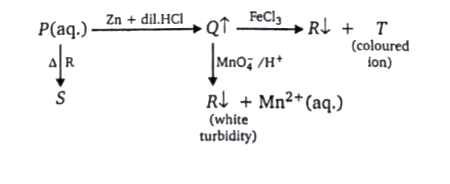Among P,S,CI,F most and least negative ΔHeg will be respectively
of :
CI,P
P,CI
CI,F
F,CI
The correct Answer is:A
To determine which element among phosphorus (P), sulfur (S), chlorine (Cl), and fluorine (F) has the most and least negative electron gain enthalpy (ΔH_eg), we can follow these steps:
Step 1: Understand Electron Gain Enthalpy
Electron gain enthalpy is the energy change when a neutral gaseous atom gains an electron to form an anion. A more negative ΔH_eg indicates that energy is released and the process is more favorable.
Step 2: Identify the Group and Period of Each Element
- Phosphorus (P) - Group 15, Period 3
- Sulfur (S) - Group 16, Period 3
- Chlorine (Cl) - Group 17, Period 3
- Fluorine (F) - Group 17, Period 2
Step 3: Analyze Trends in Electron Gain Enthalpy
1. Across a Period: As we move from left to right across a period, the electron gain enthalpy becomes more negative. This is because elements are more eager to gain electrons to achieve a stable electron configuration.
2. Down a Group: As we move down a group, the electron gain enthalpy becomes less negative. This is due to increased distance from the nucleus and increased electron shielding, making it less favorable to add an electron.
Step 4: Compare the Elements
- Fluorine (F): Being in the second period, it has a small atomic radius, but it experiences significant inter-electronic repulsion when gaining an electron due to its small 2p orbital.
- Chlorine (Cl): In the third period, it has a larger atomic radius than fluorine, reducing inter-electronic repulsion when gaining an electron, making it more favorable.
- Sulfur (S): Also in the third period, it has a less negative ΔH_eg compared to chlorine.
- Phosphorus (P): Being further left in the periodic table, it has the least negative ΔH_eg among these elements.
Step 5: Conclusion
- Most Negative ΔH_eg: Chlorine (Cl) has the most negative electron gain enthalpy due to its larger size compared to fluorine, allowing for easier electron addition.
- Least Negative ΔH_eg: Phosphorus (P) has the least negative electron gain enthalpy because it is further left in the periodic table and less inclined to gain electrons compared to the others.
Final Answer
- Most negative ΔH_eg: Chlorine (Cl)
- Least negative ΔH_eg: Phosphorus (P)
Electron gain enthalpy is the energy change when a neutral gaseous atom gains an electron to form an anion. A more negative ΔH_eg indicates that energy is released and the process is more favorable.
- Phosphorus (P) - Group 15, Period 3
- Sulfur (S) - Group 16, Period 3
- Chlorine (Cl) - Group 17, Period 3
- Fluorine (F) - Group 17, Period 2
1. Across a Period: As we move from left to right across a period, the electron gain enthalpy becomes more negative. This is because elements are more eager to gain electrons to achieve a stable electron configuration.
2. Down a Group: As we move down a group, the electron gain enthalpy becomes less negative. This is due to increased distance from the nucleus and increased electron shielding, making it less favorable to add an electron.
- Fluorine (F): Being in the second period, it has a small atomic radius, but it experiences significant inter-electronic repulsion when gaining an electron due to its small 2p orbital.
- Chlorine (Cl): In the third period, it has a larger atomic radius than fluorine, reducing inter-electronic repulsion when gaining an electron, making it more favorable.
- Sulfur (S): Also in the third period, it has a less negative ΔH_eg compared to chlorine.
- Phosphorus (P): Being further left in the periodic table, it has the least negative ΔH_eg among these elements.
- Most Negative ΔH_eg: Chlorine (Cl) has the most negative electron gain enthalpy due to its larger size compared to fluorine, allowing for easier electron addition.
- Least Negative ΔH_eg: Phosphorus (P) has the least negative electron gain enthalpy because it is further left in the periodic table and less inclined to gain electrons compared to the others.
- Most negative ΔH_eg: Chlorine (Cl)
- Least negative ΔH_eg: Phosphorus (P)
Topper's Solved these Questions
- CHEMISTRY AT A GLANCEBOOK - ALLENCHAPTER - CHEMISTRY AT A GLANCEEXERCISE - ORGANIC CHEMISTRY
472 Videos
- CHEMISTRY AT A GLANCEBOOK - ALLENCHAPTER - CHEMISTRY AT A GLANCEEXERCISE - ORGANIC CHEMISTRY
472 Videos
- Chemical EquilibriumBOOK - ALLENCHAPTER - Chemical EquilibriumEXERCISE - All Questions
30 Videos
- ELECTROCHEMISTRYBOOK - ALLENCHAPTER - ELECTROCHEMISTRYEXERCISE - EXERCISE -05 [B]
38 Videos
Similar Questions
The value of IIndΔegH of O & S respectively in KJ/mole :-
View SolutionWhich WBC are the most abundant and least in number respectively ?
View SolutionThe least and most stable resonating structure respectively are :

View SolutionAmong the following, the least and the best HΘ ion donor, respectively, are:
View SolutionAmong the following, the least and the best HΘ ion donor, respectively, are:
View SolutionAmong the following, the best and the least HΘ ion donor, respectively, are:
View SolutionAmong the following, the best and the least HΘ ion donor, respectively, are:
View Solution
Q. Species P and S are respectively:
View SolutionWhich of the following is the least and most abundant leucocytes in human blood, respectively ?
View SolutionWhich one of the following arrangement represents the correct order of least negative to most negative electron gain enthalpy for C , Ca , AI , F and O ?
View Solution
